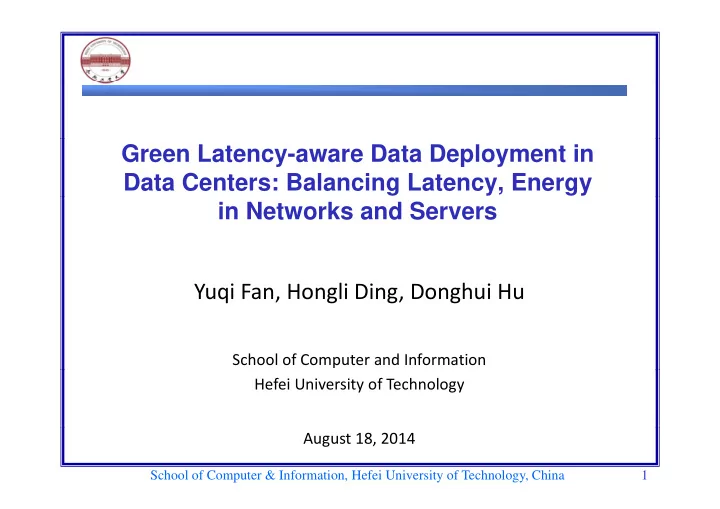

Green Latency-aware Data Deployment in Data Centers: Balancing Latency, Energy in Networks and Servers Yuqi Fan, Hongli Ding, Donghui Hu School of Computer and Information Hefei University of Technology August 18, 2014 School of Computer & Information, Hefei University of Technology, China 1
Model DC 2 DC 2 DC 3 DC 3 DC 1 DC i School of Computer & Information, Hefei University of Technology, China 2
Motivation • Two concerns exist in service provisioning by data centers – Users require to experience low latency while Users require to experience low latency while accessing data from the data centers – Reduce the power consumed by network transport Reduce the power consumed by network transport and servers in the data centers School of Computer & Information, Hefei University of Technology, China 3
Problem • We tackle the problem of green data deployment in the data centers, taking into account the three factors of latency, energy consumption of the data centers and the network transport • The cost of deploying data on a server in a data The cost of deploying data on a server in a data center integrates the three factors above – each factor has a coefficient in the cost function h f h ffi i i h f i School of Computer & Information, Hefei University of Technology, China 4
Objective Function School of Computer & Information, Hefei University of Technology, China 5
• , , and are the weights of the sub-objectives of 1 2 3 the latency, the energy consumption of the data h l h i f h d centers and the network transport, respectively. • rep(dc j , s m , d k ) indicates whether data d k is deployed in server s m in data center dc j . j • p(u i | d k ) is the probability that a given request is asking for data d k and it comes from user group u i g g p k i. • l(u i , dc j ) is the latency between user group u i and data center dc j center dc j. • rep(dc j , s m ) is the indicator whether server s m in data center dc has been deployed some data center dc j has been deployed some data School of Computer & Information, Hefei University of Technology, China 6
• e S (dc j , s m ) is the energy consumption of server s m in d data center dc j. d • s(d k ) is the size of data d k . • e I (u i , dc j ) is the energy required to transport one bit from data center dc j to user group u i through the Internet. Internet • PUE(dc j ) is the PUE of data center dc j is the power of sever s in data center dc j sever s m in data center dc j . • C(s m , dc j ) is the capacity of server s m in data center Dc j . j School of Computer & Information, Hefei University of Technology, China 7
GLDD (Green Latency-aware Data Deployment) Deployment) • When processing each data chunk d k , GLDD searches the servers in all the data centers with the h h i ll h d i h h least cost to deploy data d k . • Each server in each data center is checked to obtain the cost to accommodate data d k on the server if the server has enough capacity. • The cost of deploying data d k on server s m in data p y g k m center dc j integrates the three factors of the latency, the power consumed by the servers and the network p y transport. School of Computer & Information, Hefei University of Technology, China 8
School of Computer & Information, Hefei University of Technology, China 9
Result We evaluate the performance of the algorithm GLDD by comparing GLDD with the algorithm FORTE proposed in SIGCOMM'12. p p School of Computer & Information, Hefei University of Technology, China 10
Recommend
More recommend